-
Hearts for Valentine’s and wild bird feeders
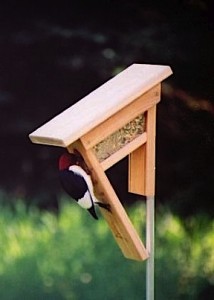 Hearts aren’t just for Valentine’s day!
Hearts aren’t just for Valentine’s day!
Feeding sunflower hearts or a no-waste mix greatly reduces ground mess below your bird feeders. Some home owners have backed off from feeding birds, as the ground waste may have attracted other, less desirable critters (especially if the house sat in close proximity to a wooded area). But there are lots of ways to still feed birds… without the mess!
The no-waste mixes and sunflower hearts & chips are a perfect choice for most types of wild bird feeders as a great variety of species enjoy these premium seeds. They may cost a little more, but it’s money well spent if you’d still like to see those beaked buddies in your yard, sans the ground mess. Anything that does fall to the ground will not be left for long, as ground feeding birds who eat seeds (like cardinals, doves, juncos, chipping sparrows, towhees) will snatch this premium meal up before it has time to sit.
Using a seed tray or seed catcher will also help to eliminate ground mess. The adjustable trays actually serve as an additional feeder with their large platform area. Today’s seed catchers need not attach directly to the bottom of the bird feeder either. Hanging trays offer several installation options, and larger platforms are made to fit on feeder poles or 4×4 posts below the feeder. Birds who’ve never used the feeder itself will utilize the platform for a meal of fallen seed.
Suet is another great way to feed birds sans any ground waste. It’s neat & clean,
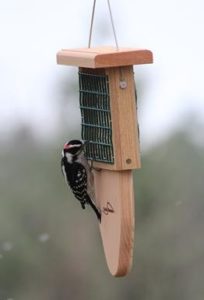 economical and easy to feed. Clinging birds like chickadees, nuthatches and titmice like it, and you can’t beat it for cold weather feeding! Packed with fat and protein, suet provides those extra calories for energy needed to stay warm. Standard suet cages are great, but a suet cage with tail prop will entice woodpeckers too. The extended panel below the cage gives them leverage to “prop” their tail and perch more comfortably. Guess it’s the difference between a metal folding chair and a Lazy-Boy!
economical and easy to feed. Clinging birds like chickadees, nuthatches and titmice like it, and you can’t beat it for cold weather feeding! Packed with fat and protein, suet provides those extra calories for energy needed to stay warm. Standard suet cages are great, but a suet cage with tail prop will entice woodpeckers too. The extended panel below the cage gives them leverage to “prop” their tail and perch more comfortably. Guess it’s the difference between a metal folding chair and a Lazy-Boy!Wild bird feeders come in a gazillion style colors! First step is to figure out what birds you’d like to attract. Specialty feeders exist for everyone… from hummingbirds and bluebirds, to Goldfinches and Orioles. Of course fresh water is always an excellent method to entice birds, and some form of birdbath (even a saucer) should always be considered in any bird-friendly habitat.
-
encourage birds to nest in that edible birdhouse after the party’s over!
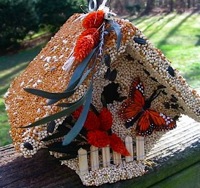 So all the food’s gone and the party is over, right? Nope… the fun is just start starting with spring not too far off! And if anything like last year, spring will again come early 🙂
So all the food’s gone and the party is over, right? Nope… the fun is just start starting with spring not too far off! And if anything like last year, spring will again come early 🙂Although it makes an awesome feeder, the All Season’s Wren Casita edible birdhouse is the perfect nest site-for more than just wrens. Some folks have inquired how to re-seed them for extended use as feeders. I suppose peanut butter might work as a good base… but the manufacturer sure isn’t giving away their secret so fast!
So just how does one encourage nesting? It’s all about habitat, so start by offering a fresh water source. No fancy-pants birdbath needed, (unless you’d like one in your yard) something as simple as a plant saucer filled with water works great. On the deck, step, rail, tree stump…wherever! Drill three holes in the sides of a plastic one and make a quick hanging bath should ground predators lurk in your yard (cats). Optimal depth is just 2-3 inches for birds to bathe and wade comfortably. If your dish or saucer is deeper, consider a large rock in the center for birds to perch, or lining the bottom with river rock, or a few layers of pebbles.
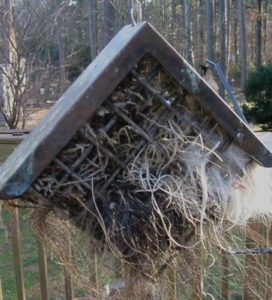 Next… nesting materials! Again, you can do this one yourself, no fancy store-bought kits necessary (but we do offer some cool ones). Figure out a vessel to hold the materials; a suet cage works great, as does a mesh produce bag from the grocery store (like the kind apples come in). Then start to gather the goods! Some favorites include:
Next… nesting materials! Again, you can do this one yourself, no fancy store-bought kits necessary (but we do offer some cool ones). Figure out a vessel to hold the materials; a suet cage works great, as does a mesh produce bag from the grocery store (like the kind apples come in). Then start to gather the goods! Some favorites include:- Decorative mosses like Spanish, sphagnum, green sheet moss, raffia, and that dried straw stuff. Pluck some from one of your house plants!
- Feathers are adored by tree swallows, and bluebirds have been known to add a few here and there as well. Really cheap at a craft store, or any un-dyed feather duster will do-preferably clean.
- Bright cotton yarns, save these from anywhere you can
- Pet hair is huge favorite of chickadees, titmice, wrens and others. (Not recommended if treated with flea/tick medication)
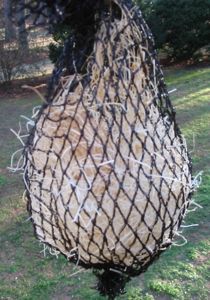 Live anywhere near a horse farm? Horse hair is the best, and we give it away in the spring! The key is to get the materials out before nesting season actually starts. That way birds see it and become familiar, knowing that when it’s time, the goods are right there for the pickins! Avoid placing materials in any birdhouses as avian amigos prefer to do their own decorating! Simply hang from a branch where they’ll see it. Also, don’t pack the vessel too tightly, as you’ll want the materials to dry quickly after a rain shower.
Live anywhere near a horse farm? Horse hair is the best, and we give it away in the spring! The key is to get the materials out before nesting season actually starts. That way birds see it and become familiar, knowing that when it’s time, the goods are right there for the pickins! Avoid placing materials in any birdhouses as avian amigos prefer to do their own decorating! Simply hang from a branch where they’ll see it. Also, don’t pack the vessel too tightly, as you’ll want the materials to dry quickly after a rain shower.Offering nesting materials will absolutely encourage nest building around your yard, and extend the use of that edible birdhouse!
Thanks for housing the birds 🙂
-
how would window bird feeders ever be versatile?
 Because with The Great Hang Up, you can turn most smaller hanging feeders into window bird feeders. Although it may not look like much, this innovative window hook holds up to three pounds securely. It leaves options wide open for attracting avian
Because with The Great Hang Up, you can turn most smaller hanging feeders into window bird feeders. Although it may not look like much, this innovative window hook holds up to three pounds securely. It leaves options wide open for attracting avian 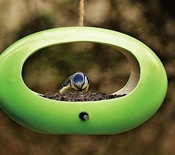 friends… up close and personal, with the hook facing both up or downwards.
friends… up close and personal, with the hook facing both up or downwards.The Mod Oval shown here would be great as a window feeder, offering a full view of dining birds.
Come to think of it, a window birdbath would be fantastic too! Since fresh water is a great way to entice birds, small dish-type feeders (with no drainage) would serve this purpose well. The Glass Globe feeder
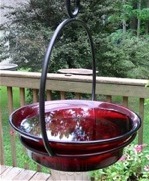 is versatile enough to fit the bill. Accommodating seed mixes, suet & nuggets, peanuts, even fruit in summer, plain old water is an excellent option as well. Available in ruby red or lime green… just think of the possibilities!
is versatile enough to fit the bill. Accommodating seed mixes, suet & nuggets, peanuts, even fruit in summer, plain old water is an excellent option as well. Available in ruby red or lime green… just think of the possibilities!Aside from the awesome viewing opportunities, here’s another reason why window bird feeders are good – location, or placement is important for birds’ safety. According to The Cornell Lab of Ornithology, placing a feeder within three feet (or more than thirty feet) from windows greatly helps to prevent window strikes. They say billions of birds die each year from these fatal crashes. Using the above reference for feeder placement will not afford birds enough room for gaining speed and crashing into the window.
So think outside the box because it doesn’t have to actually say “window feeder” to be one!
